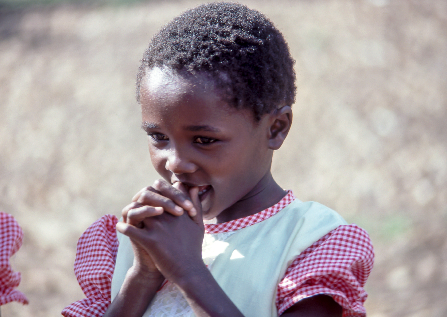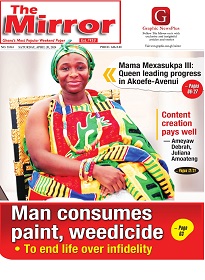The Mirror's Health , Lifestyle and Fashion

Surviving childhood cancer - Correct, early diagnosis, full treatment critical
The Ghana Health Service (GHS) estimates that a 1,000 children are affected annually but unfortunately, only 30 per cent of the affected children received any form of treatment.
Advertisement
Avoidable deaths from childhood cancers in Low and Middle-Level Income Countries (LMICs) result from lack of diagnosis, misdiagnosis or delayed diagnosis, obstacles to accessing care, abandonment of treatment, death from toxicity, and higher rates of relapse.
Cancer is a major cause of death in children and adolescents, particularly in LMICs like Ghana.
The World Health Organisation(WHO) advocates that because cancers in children and adolescents are generally not possible to prevent, the most effective strategy to reduce the burden of cancer in children and improve outcomes is to focus on a prompt, correct diagnosis followed by effective, evidence-based therapy with tailored supportive care.
Unfortunately, cancer is not on the top of the list of health conditions that parent’s lookout for even when children show its known symptoms due to lack of information, among other reasons, and coupled with diagnosis skill gaps at the primary healthcare levels.
Childhood cancer
Childhood cancer is a term used to describe cancers that occur between birth and 15 years of age.
Cancers in children are associated with certain physical signs that could facilitate early diagnosis and treatment for affected children and help to increase their survival rate.
They may differ from adult cancers in the way they grow and spread, how they are treated and how they respond to treatment.
The most common types of childhood cancers include leukemias, brain cancers, lymphomas and solid tumours, such as neuroblastoma and Wilms tumours.
Also known as paediatric cancer, the common types include leukaemia (begins in blood-forming tissue such as bone marrow), lymphoma (begins in the cells of the immune system), neuroblastoma (begins in certain nerve cells), retinoblastoma (begins in the tissues of the retina), Wilms tumour (a type of kidney cancer), and cancers of the brain, bone and soft tissue.
Common signs associated with childhood cancers are unexplained weight loss; headaches, often with early morning vomiting; increased swelling or persistent pain in the bones, joints, back, or legs; lump or mass, especially in the abdomen, neck, chest, pelvis or armpits, development of excessive bruising, bleeding or rashes.
Others include constant, frequent or persistent infections; a whitish colour behind the pupil; nausea that persists or vomiting without nausea; constant tiredness or noticeable paleness; eye or vision changes that occur suddenly and persist; recurring or persistent fevers of unknown origin
These signs and symptoms may not necessarily be cancer since there are other diseases that present with the same symptoms.
However, it is important that a doctor conducts further checks to give the appropriate treatment.
Unlike cancer in adults, the vast majority of childhood cancers do not have a known cause. Many studies have sought to identify the causes of childhood cancer, but very few cancers in children are caused by environmental exposure or lifestyle factors.
Health experts say early detection is life saving for children and have called on all parents not to take signs or any changes they see in their children for granted, but should always seek early treatment or medical opinion on time.

Cure
According to the Head of the Paediatric Oncology Unit at the Korle-Bu Teaching Hospital, Professor Lorna Awo Renner, 80 per cent of childhood cancers are curable, “but this is dependent on early detection and progressive treatment.”
Although more than 80 per cent of children with cancer live in developing countries like Ghana, only about 20 to 30 per cent of them receive such treatment. This is often due to inhibitive costs.
In Ghana, where cancer treatment is not covered by the National Health Insurance Scheme (NHIS), the average expenditure for treating childhood cancer is about US $1000. In the treatment of Leukaemia, it can reach as high as $ 7000 for up to three years. This is far beyond the means of many Ghanaians.
Prof. Renner also appealed to parents to often examine their children critically so that such changes could be picked and reported on time.
“The likelihood of surviving a diagnosis of childhood cancer depends on the country in which the child lives: in high-income countries, more than 80 per cent of children with cancer are cured, but in many LMICs only between 15-45 per cent are cured,” she said.
She said when identified early, cancer was more likely to respond to effective treatment and result in a greater probability of survival, less suffering, and often less expensive and less intensive treatment.
Significant improvements can be made in the lives of children and adolescents with cancer by detecting cancer early and avoiding delays in care. A correct diagnosis is essential to treat children with cancer because each cancer requires a specific treatment regimen that may include surgery, radiotherapy, and chemotherapy.
Early diagnosis
Prof. Renner said early detection was life-saving for children, and called on all parents not to take signs or any changes they see in their children for granted but should always seek early treatment or medical opinion on time.
The Director-General of the GHS, Dr Patrick Kuma-Aboagye, advocated that early diagnosis was a shared responsibility between healthcare providers, the family and the society as a whole.
That, he said, was because the childhood and adolescent cancers were associated with a range of warning symptoms that could be detected by families and by trained primary healthcare providers.
Society
“These statistics, undoubtedly, raise the question of access to childhood cancer care or treatment. Currently, the country can boast only two childhood cancer treatment facilities — the main teaching hospitals of Korle Bu and Komfo Anokye — and only recently the Greater Accra Regional Hospital,” Dr Kuma-Aboagye said.
A national childhood cancer society has been inaugurated to help ensure that all childhood cancers are picked and offered the necessary holistic treatment to improve national survival rates.
It is known as the Childhood Cancer Society of Ghana (CCSG) and its establishment was facilitated by the two main childhood cancer treatment centres in the country, Korle Bu Teaching Hospital and Komfo Anokye Teaching Hospital.
Writer’s email: [email protected]





